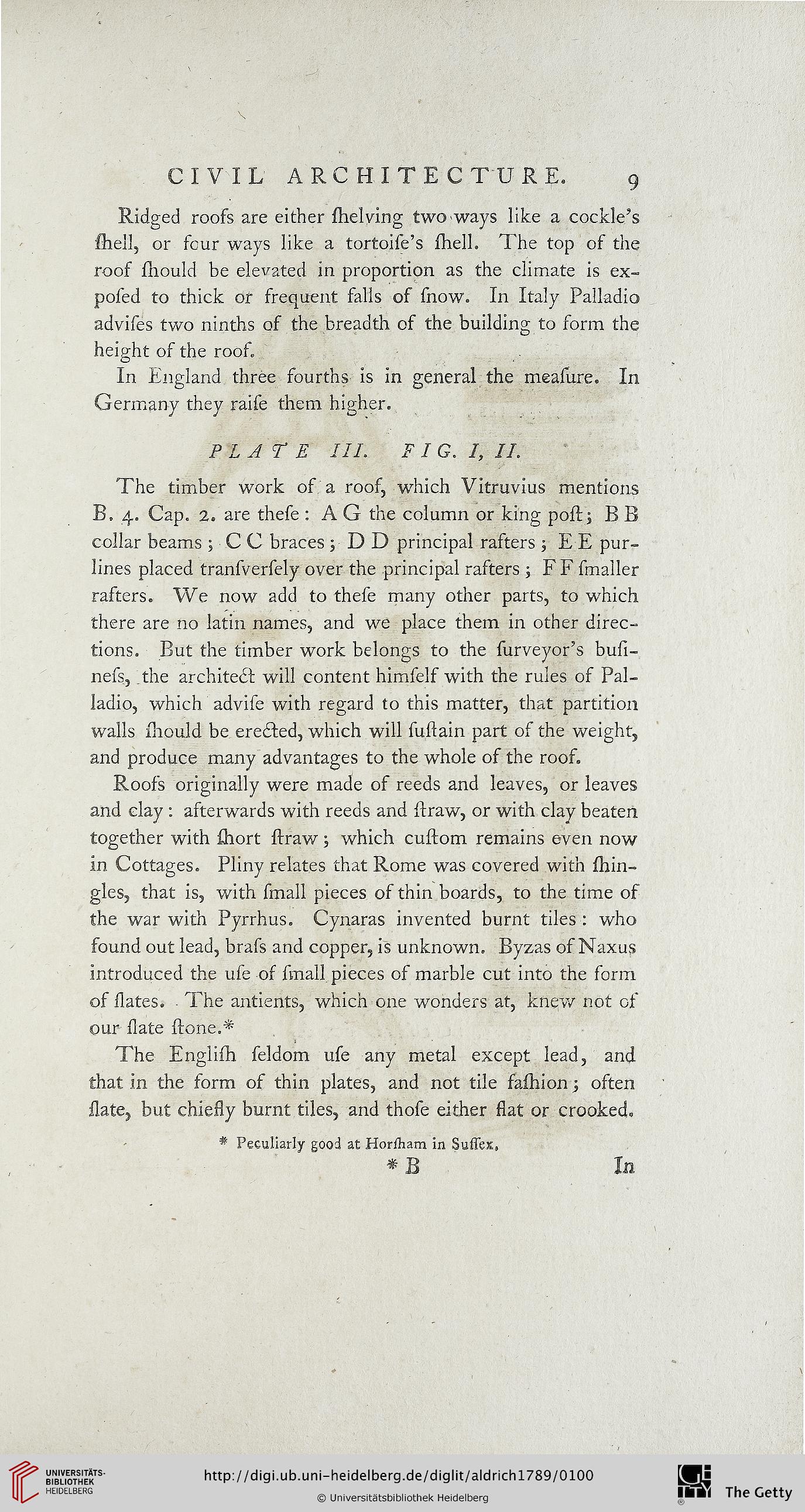CIVIL ARCHITECTURE.
9
Ridged roofs are either shelying two ways like a cockle’s
shell, or fcur ways like a tortoise’s shell. The top of the
roof should be elevated in proportion as the climate is ex-
posed to thick or frequent falls of snow. In Italy Palladio
advises two ninths of the breadth of the building to form the
height os the roos.
In England three sourths is in general the measure. In
Germany they raise them higher.
PLATE ILL FIG. /, II.
The timber work of a roof, which Vitruvius mentions
B, 4. Cap. 2. are these : A G the column or king poll; B B
collar beams ; CC braces ; DD principal rafters ; E E pur-
lines placed transversely over the principal rafters ; FF smaller
rafters. We now add to these many other parts, to which
there are no latin names, and we place them in other direc-
tions. But the timber work belongs to the surveyor’s busi-
ness, the architect will content himself with the rules of Pal-
ladio, which advise with regard to this matter, that partition
walls should be eredted, which will sustain part of the weight,
and produce many advantages to the whole of the roos.
Roofs originally were made of reeds and leaves, or leaves
and clay : asterwards with reeds and slraw, or with clay beaten
together with short straw; which custom remains even now
in Cottages. Pliny relates that Rome was covered with shin-
gles, that is, with small pieces of thin boards, to the time of
the war with Pyrrhus. Cynaras invented burnt tiles : who
found out lead, brass and copper, is unknown. Byzas of Naxus
introduced the use of small pieces of marble cut into the form
of dates. The antients, which one wonders at, knew not of
our date Hone.*
The English seldom use any metal except lead, and
that in the form of thin plates, and not tile fashion; often
date, but chiedy burnt tiles, and those either siat or crooked,
* Peculiarly good at Horlham in Sussex,
* B In
9
Ridged roofs are either shelying two ways like a cockle’s
shell, or fcur ways like a tortoise’s shell. The top of the
roof should be elevated in proportion as the climate is ex-
posed to thick or frequent falls of snow. In Italy Palladio
advises two ninths of the breadth of the building to form the
height os the roos.
In England three sourths is in general the measure. In
Germany they raise them higher.
PLATE ILL FIG. /, II.
The timber work of a roof, which Vitruvius mentions
B, 4. Cap. 2. are these : A G the column or king poll; B B
collar beams ; CC braces ; DD principal rafters ; E E pur-
lines placed transversely over the principal rafters ; FF smaller
rafters. We now add to these many other parts, to which
there are no latin names, and we place them in other direc-
tions. But the timber work belongs to the surveyor’s busi-
ness, the architect will content himself with the rules of Pal-
ladio, which advise with regard to this matter, that partition
walls should be eredted, which will sustain part of the weight,
and produce many advantages to the whole of the roos.
Roofs originally were made of reeds and leaves, or leaves
and clay : asterwards with reeds and slraw, or with clay beaten
together with short straw; which custom remains even now
in Cottages. Pliny relates that Rome was covered with shin-
gles, that is, with small pieces of thin boards, to the time of
the war with Pyrrhus. Cynaras invented burnt tiles : who
found out lead, brass and copper, is unknown. Byzas of Naxus
introduced the use of small pieces of marble cut into the form
of dates. The antients, which one wonders at, knew not of
our date Hone.*
The English seldom use any metal except lead, and
that in the form of thin plates, and not tile fashion; often
date, but chiedy burnt tiles, and those either siat or crooked,
* Peculiarly good at Horlham in Sussex,
* B In





